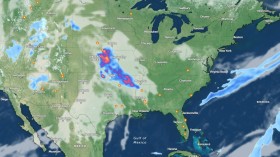Megastorm floods in California might be the solution to the state's protracted droughts.
Halfway between Los Angeles and Sacramento, the Arroyo Pasajero Creek runs through land that is sometimes too dry to farm and other times is dangerously flooded.
A group of local farmers and the neighboring city of Huron are attempting to transform former hemp and tomato fields into enormous containers that can hold water as it permeates into the ground throughout wet years amid the cycles of wet and dry, both phenomena that are made worse by climate change.
This project, as well as similar ones being undertaken throughout California's Central Valley, aims to divert floodwaters that would normally rush to the sea or cause damage to towns, cities, and agricultural fields.
The conventional method of storing water involves damming rivers to construct reservoirs, which harms the environment.
Water became so scarce in the Central Valley this year due to parts of California experiencing a historic drought that Huron was only given 25% of the water it had contracted to acquire from the US Bureau of Reclamation.
An article published in NBC Bay Area detailed how this concept started.
Recharge System
According to engineering consultant Alfonso Manrique, the city, one of the poorest in California, had to purchase water on the open market, increasing costs for residents.
The new project, called a recharge system, converts unused fields into sizable ponds to hold water so that it can permeate into the porous earth and rocks below, creating or restoring an aquifer instead of rushing to the sea.
According to Manrique, the city is building a new well that will be fed from the aquifer.
Additionally, capturing runoff will help safeguard the less than 7,000-person city from disastrous floods.
The project near Huron is only one of about 340 recharge systems that California water agencies have proposed; if all of them are built by 2030, they would be able to store 2.2 million acre-feet, according to the state Department of Water Resources which is enough for 4.4 million households for the whole year, Digital Journal reported.
Rey Leon, the mayor of Huron, wants to make water more affordable for the locals.
Efforts in California
Even though the concept of holding water underground is not new, a recent California law limits the use of groundwater, sparking several projects that the state is helping to finance.
The Tulare Irrigation District is constructing a new recharge pond in the tiny community of Oakville, which is located about 40 miles east of Huron, on land that was bought from a nearby farmer, according to the district's general manager Aaron Fukuda.
Several Okieville residents experienced water shortages during the state's most recent severe drought, which lasted from 2012 to 2016.
The new pond, which is located on about 20 acres of former farmland, will assist in directing water underground so that it can be stored for both residents and agriculture.
Amounts from state grants totaling $1.8 million of the project's estimated $2 million cost.
A 1,500-acre recharge pond is being built in the high desert near Palmdale by the massive Metropolitan Water District in collaboration with local water authorities, in addition to the relatively small projects being developed by rural water districts and farmers.
Metropolitan Water District is a regional water wholesaler serving Southern and parts of Central California.
Read also: How can We Tame These Urban Floods? Here's What You Need to Understand
Engineering Marvels or Environmental Hurdles?
When the state and federal governments constructed California's intricate networks of reservoirs, rivers, and aqueducts in the middle of the 20th century, they were thought to be engineering marvels.
However, the system was based on flooding canyons, diverting and damming rivers, and destroying their ecosystems.
In 1980, a significant dam was constructed. The population of the state has roughly doubled to 40 million people since that time.
One of the largest agricultural economies in the world, California relies heavily on irrigation to grow its crops, further taxing the infrastructure.
New reservoirs are now expensive to build and difficult to get approved for.
The underground storage projects will be simpler to finance, grant permits for, and receive more support from the general public, according to Ann Hayden, a water expert at the Environmental Defense Fund.
Underground Water Bank
According to Sarah Woolf, these man-made aquifers and underground water banks won't completely solve California's water problems, but they can make a big dent.
Woolf is a water consultant. Her family owns some of the farmland used for the Huron project.
A million acre-feet, or 326 billion gallons, of water, can be stored below the agricultural land that the Huron project will serve, providing a year's worth of water for 2 million households, Reuters reported.
Related article: Scientists Point to Great Flood of 1862 in Study About California Megaflood Possibilities
© 2024 NatureWorldNews.com All rights reserved. Do not reproduce without permission.


![Roundworms with Short Memories 'Stop Forgetting' When Frozen or Given Lithium [Study]](https://1471793142.rsc.cdn77.org/data/thumbs/full/70295/280/157/50/40/roundworms-with-short-memories-stop-forgetting-when-frozen-or-given-lithium-study.jpg)


